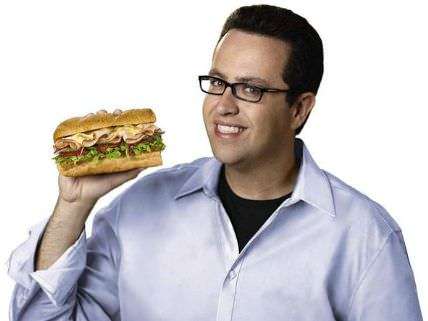Why Jared Fogle's Child Porn Plea Deal Makes Sense
His sentence could have been much longer under federal law (and much shorter under state law).

Federal prosecutors in Indiana say former Subway pitchman Jared Fogle has agreed to plead guilty to receiving and distributing child pornography as well as having sex with minors. Unlike his associate Russell Taylor, who ran Fogle's charitable foundation, Fogle was not charged with producing child pornography, and the teenagers he reportedly had sex with at New York City hotels were 16 and 17. Under the plea deal he nevertheless faces at least five years in prison and could serve as long as 12 years.
That seems pretty steep, especially since the age of consent in New York is 17, which means only one of his liaisons was a crime under state law (leaving aside the question of whether money changed hands). For someone 21 or older, sex with a 16-year-old, a.k.a. "rape in the third degree," is a Class E felony in New York, punishable by anything from probation to four years in jail. In Indiana, where Fogle lives, possessing child pornography can be treated as a misdemeanor punishable by at least six months in jail or a felony punishable by up to three years in prison. Sharing child pornography, which Fogle also admitted doing, is a Class C felony punishable by two to eight years in prison.
But Fogle was charged under federal law, so his deal makes sense. Under federal law, receiving child pornography, which could mean downloading a single image, triggers a mandatory minimum sentence of five years—the same as the penalty for distributing it. Merely looking at a picture can qualify someone for the same charge, assuming he does so deliberately and is aware that Web browsers automatically make copies of visited sites.
In practice, since the Internet is almost always the source of child pornography, this means that viewing and possession can be treated the same as trafficking. Fogle in any case also pled guilty to distribution, which includes any sort of online sharing. The maximum penalty for receiving or distributing child porn is 20 years, and federal sentencing guidelines recommend stiff enhancements based on factors that are extremely common in these cases, such as using a computer, possessing more than 600 images (with each video clip counted as 75 images), and exchanging photos for something of value, including other photos.
In short, while Fogle might have received a sentence as short as two years under state law, he was certain to get at least five years under federal law and might very well have ended up serving longer than the 151-month maximum specified in his plea deal, depending on the enhancements. As that gap illustrates, it is not at all obvious what penalties (if any) are appropriate for consumers of child pornography. While production typically* entails the sexual abuse of children, the injury inflicted by looking at and sharing these images is much harder to pin down, let alone measure. It is therefore troubling to see such offenses treated as severely as (or more severely than) violent crimes like robbery, rape, and manslaughter.
Although legislators seem to assume that no penalty for child pornography offenses is too harsh as far as voters are concerned, they may be wrong about that. In a recent federal case, the judge asked jurors what sentence they considered appropriate for a man they had convicted of possessing and distributing child pornography. The defendant was caught with 1,500 images, and he was charged with distribution because he also had peer-to-peer file sharing software. On average, the jurors recommended a prison term of 14 months—far shorter than the mandatory minimum (five years), the sentence recommended by prosecutors (20 years), or the term indicated by federal sentencing guidelines (27 years).
Addendum: The press release about the case from the U.S. Attorney's Office for the Southern District of Indiana notes that "federal law provides strong punishment for engaging in commercial sex acts with minors under the age of 18 years," no matter what the age of consent is in the state where the sex acts occur. According to the charges against Fogle, he repeatedly received pornography produced by Taylor that involved minors ranging in age from "approximately 13-14 years old" to 16. The statement of charges says "the images or videos were produced using multiple hidden cameras concealed in clock radios positioned so that they would capture the minors changing clothes, showering, bathing, or engaging in other activities." Taylor also allegedly shared with Fogle "commercial child pornography" produced by others, and "on one occasion" Fogle "displayed to another person the commercial child pornography he obtained from Taylor on a thumb drive." That incident seems to be the basis for the distribution charge against Fogle.
Addendum II: Although Fogle's plea agreement reportedly mentions sex with a 16-year-old prostitute, the charges against him refer only to sex with a 17-year-old. ABC News says "federal prosecutors could not explain the discrepancy between the two documents."
* I originally said "necessarily," but that was too strong, since the hidden-camera material at issue in this case did not involve sexual abuse of children, and neither do nude pictures that teenagers take of themselves, which nevertheless legally qualify as child pornography.


Show Comments (433)